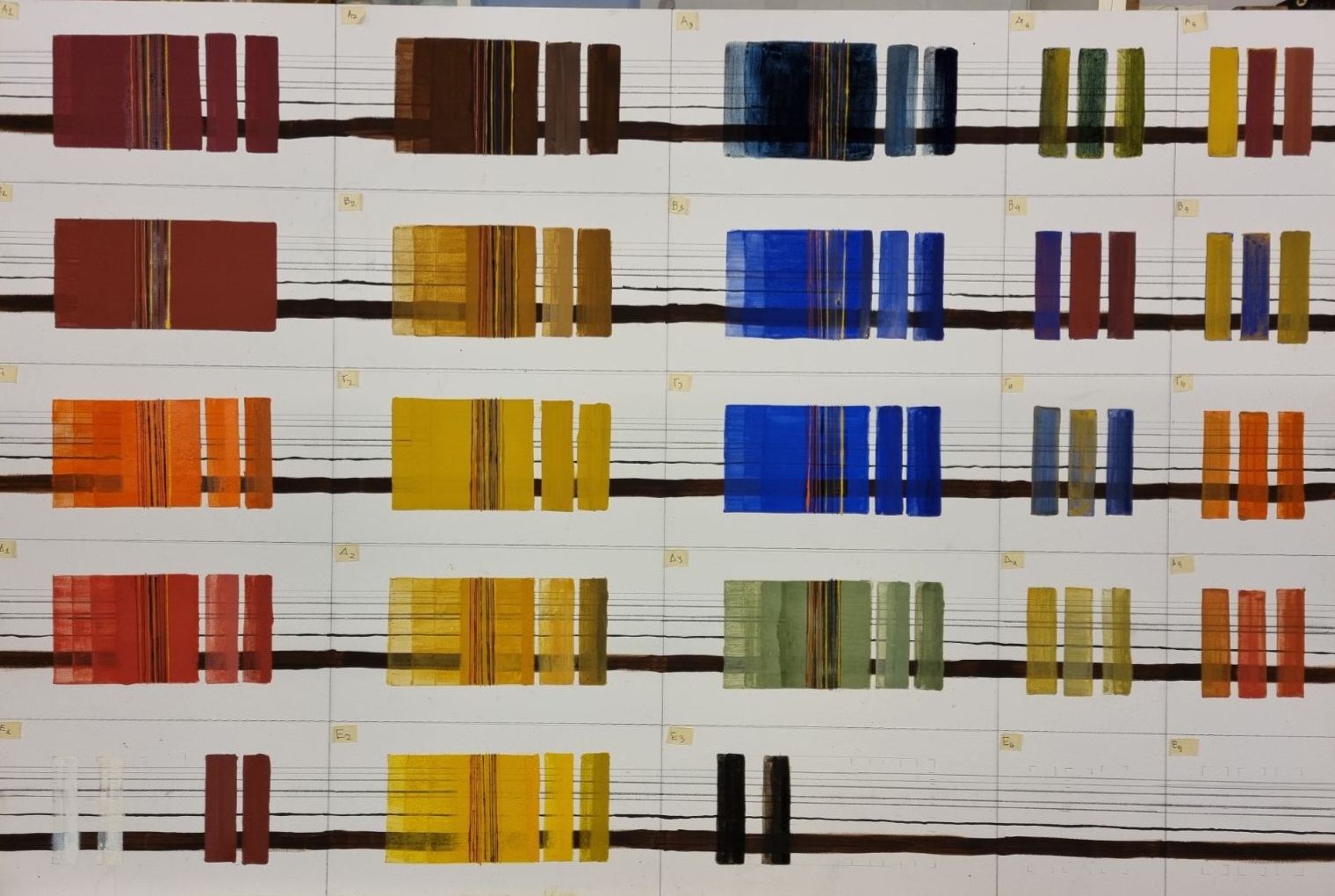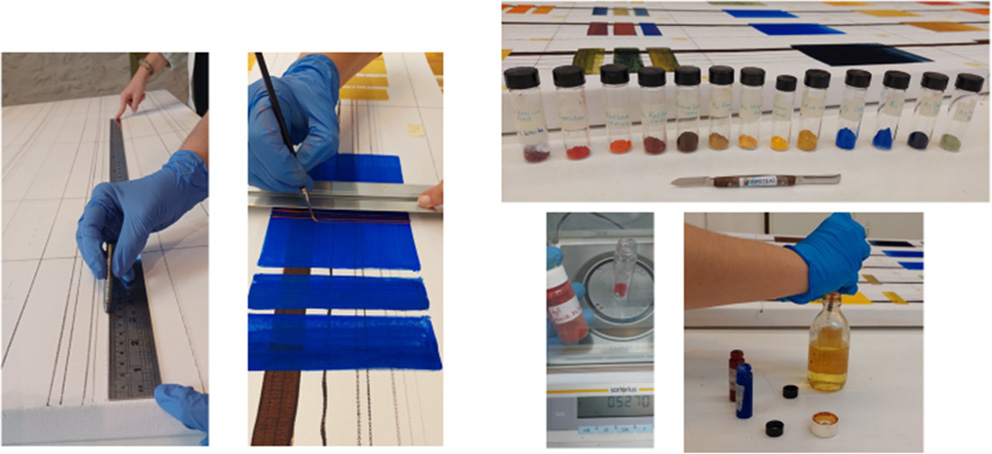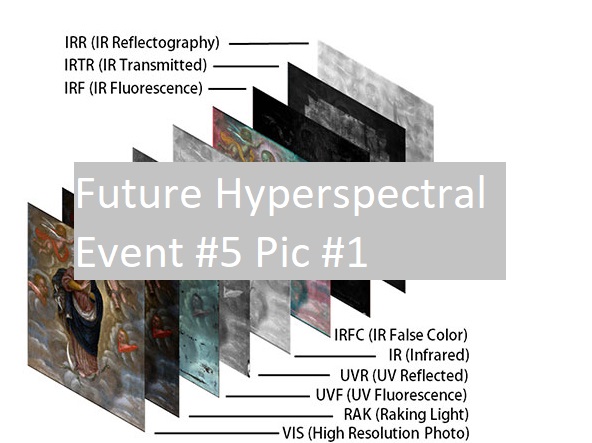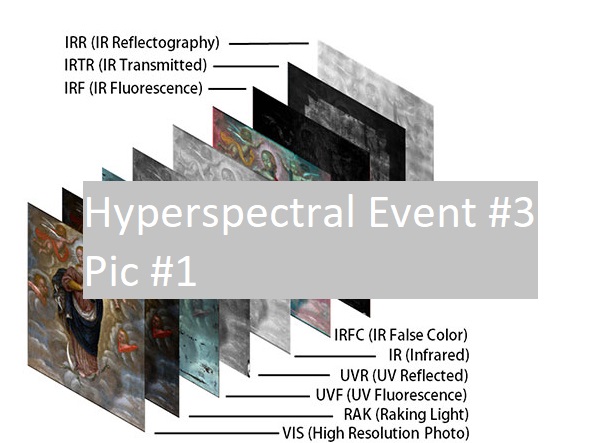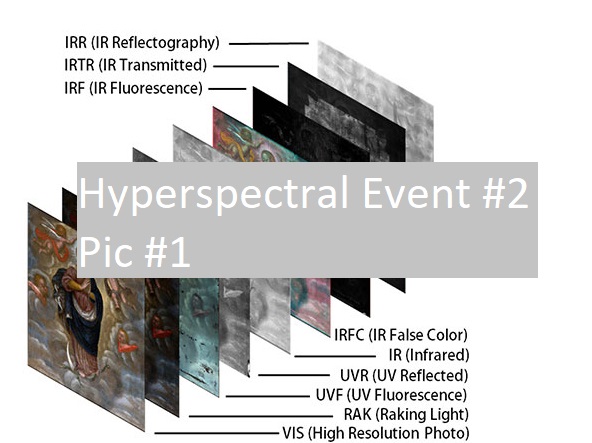The National Gallery, in collaboration with the FORTH’s Institute of Electronic Structure and Laser and the Laboratory of X-ray Spectroscopy of the National Research Centre Democritus, decided to construct a model table for the study and evaluation of analytical instruments. The project was studied using the techniques of a) Macroscopic X-Ray Fluorescence imaging, b) Diffuse Reflectance Imaging Spectroscopy, and c) Short Wavelength InfraRed (SWIR).
The construction of the model table was based on a specific protocol both for the selection of materials and for the choice of how to deposit them on the fabric substrate.
As no literature study of C.L.L. Muller’s materials and technique could be found, the choice of dyes was based on an 1875 study on materials and especially on the dyes used by Paul Delaroche, a contemporary of Muller, as well as on scientific articles concerning the construction of model specimens.
Different pigments were chosen for the construction of the model table, namely red pigments (coarse red and cadmium red), orange pigments (minium and cinnabar), yellow pigments (Naples yellow) and yellow pigments (Naples yellow), chrome yellow and yellow ochre), brown pigments (raw sienna, baked ombre and asphaltum), blue pigments (Prussian blue, ultramarime and cobalt blue), white pigments (lead white and zinc white) and black pigments (Mars black and bone black).
Linseed oil was used as a binder
Dry materials (graphite and black chalk) and wet materials (Mars black with linseed oil and as imprimatura baked ombre with linseed oil) were chosen for the drawing lines, which were applied in a specific way (e.g. thickness of the lines and distance between them) on a textile substrate (industrially prepared canvas).
Successive layers of each pigment, as well as mixtures of pigments, were applied until opacity was achieved according to a specific protocol.
Purpose
The purpose of the construction of this experimental panel was, among other things, to evaluate the analytical capability and performance of ultrafast imaging, long-wavelength infrared reflectography and MA-XRF arrays, as well as to determine the requirements and specifications for the construction of a physical platform for scanning large-scale projects. This purpose largely dictated the form of the experimental panel.
Thus, the experimental panel was preferred to be of large dimensions, namely 1.00 x 1.50 m. In addition, the researchers applying the imaging techniques suggested that the colour areas should be distinct from each other and not adjacent, and that the panel should include colour lines of small thickness spaced at most 2 mm apart.
On the other hand, it was suggested by the EPMAS researchers to include in the experimental table draft lines with both dry and wet medium, as well as mixtures of black and white dyes, and some common dye mixtures from the selected ones. With these data no effort was made to obtain the maximum possible number of overlapping colour layers and with different, indeed, thicknesses.
Choice of substrate and preparation
As can be seen from the literature review, when a textile substrate is used, industrially prepared canvas is generally used. And in the case of the experimental panel constructed for the study of the Charles-Louis-Lucien Muller panel, industrially prepared canvas was considered a safe and adequate choice.
Selection of the material of the draft
Two dry and two wet media were selected as the draft materials. The dry media were chosen in principle on the basis of the period and are graphite pencil (monolith graphite pencil, CRETACOLOR company) and black chalk pencil (black chalk pencil, CRETACOLOR company). Another argument for choosing these two dry media is that the painting depicts a representation with too many forms and details, very close to each other, and the hypothesis is made that if a dry medium has been used for the sketch this would be an easier material to create a precise line, unlike, for example, charcoal. Thus with regard to graphite it is known that it seems to have been first used for drafts in the 16th century, displacing the lead spike. However, it was not a material that was commonly used until the end of the 17th century, and it gained widespread use as an artistic material in the late 18th century, and synthetic graphite was produced commercially from 1897 (Brooks 2010; Oxford University Press 2018).
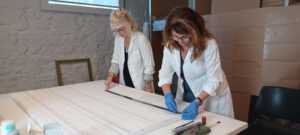
Selection of the binder
In general, most researchers use linseed oil, with different preparation in some cases. Walmsley et al. (1994) used cold-pressed linseed oil. In the case of the experimental panel constructed for the study of the Charles-Louis-Lucien Muller panel also linseed oil. It was also decided to use white spirit to dry the painting mixture more quickly, and in particular for every 1 ml of linseed oil, 5 ml of white spirit was added.
Selection and control of pigments
As stated, the type of dyes to be used for the construction of reference samples and experimental panels should be selected after an extensive literature review and all researchers agree on this (Walmsley et al. 1994, Persia et al. 2005, IFAC 2007, etc.). In this case, the pigments chosen in principle are those attested to have been used by Paul Delaroche based on the rationale developed above. In addition to these, some other pigments were chosen which were innovative for their time, e.g. cadmium and chromium pigments. In particular with regard to green pigments, it is observed that no green pigment is mentioned in Delaroche’s list of pigments (Fig. 29) . However, it was decided to include green earth in the experimental table, on the one hand because it is a natural earthy pigment used throughout time from antiquity to the present day and on the other hand because it is a “challenge” for the MA-XRF technique due to the many elements it contains.
The following table shows the final set of pigments included in this experimental panel.
Table 1. Final set of pigments included in the standard table.The mixtures of pigments created, after several tests it was decided to keep the ratio of 5%w/w in all of them.
With regard to the mixtures of pigments with white, it was decided that all pigments should be mixed with lead white except for cadmium red and yellow chrome which were mixed with zinc white. The rationale behind this decision is that lead white was the most widely used pigment over time until its virtual abolition in the 20th century due to its toxicity. On the other hand, a painter who used chrome and cadmium pigments at the time the work in question was produced is very likely to have used zinc white as a white pigment, since all these pigments were considered relatively ‘modern’ in 1855. After trials it was decided that the 50%w/w ratio should be adhered to for all pigments.
The same reasoning was used for the selection of the pigments for a limited number of mixtures included in the experimental panel. In addition, the main criterion for mixing the pigments was the ‘usefulness’ of the resulting shades, as shown immediately below.
More specifically, the following mixtures were selected:
1) Prussian blue + Chrome yellow (shade green)
2) Cobalt blue + Red ochre (shade of purple)
3) Ultramarine blue + Naples yellow (shade of green)
4) Green earth + Naples yellow (shade light green)
5) Cadmium red + Yellow ochre (shade orange)
6) Cobalt blue + Yellow ochre (shade green)
7) Minium + Raw sienna (shade light brown)
8) Cinnabar + Raw sienna (light brown shade)
Finally, in almost all mixtures, an attempt was made to mix pigments containing a “special” element, e.g. Co, Cd, Hg, with ferrous pigments (ochre).
The position of the pigments and their mixtures in the standard table – Mock up is shown schematically in the table below.
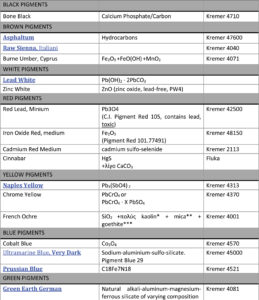
Another peculiarity concerning the dye mixtures, which is at the same time an originality of the construction process of the specific experimental panel, is a “challenge” set in terms of discriminatory power for the MA-XRF technique. More specifically, for each dye mixture (even if it is a’ and b’) that was decided to be included, a “triplet” of samples was constructed:
- A sample consisting of a layer of pure dye a’ underlying a layer of pure dye b’, even if the final visual result did not fully cover the lines of the draft.
- A specimen consisting of a layer of pure dye b’ overlying a layer of pure dye a’, even if the final optical result does not completely cover the lines of the draft.
- A sample consisting of a mixture of the a’ and b’ pigments in successive adjacent layers until all the lines of the rough draft are covered.
Ανεξάρτητα, πάντως, από το είδος των επιλεγμένων κάθε φορά χρωστικών, η βιβλιογραφία συστήνει όταν δεν πρόκειται για καθαρό χημικό συστατικό που διατίθεται από εταιρία σε συσκευασία με κωδικοποιημένη σήμανση, δηλ. στην περίπτωση προμήθειας χρωστικών σε μορφή σκόνης σε συσκευασία χωρίς σήμανση συστήνεται επιβεβαίωση της σύστασης και έλεγχος της καθαρότητας του υλικού με αναλυτικές τεχνικές (SEM-EDX, FT-IR, XRD, κλπ.). Οι χρωστικές που χρησιμοποιήθηκαν για την κατασκευή του συγκεκριμένου πειραματικού πίνακα προέρχονται από το Ινστιτούτο Ηλεκτρονικής Δομής και Λέιζερ (ΙΗΔΛ) του Ιδρύματος Τεχνολογίας και Έρευνας, και είτε είναι της εταιρίας Kremer, είτε έχουν ταυτοποιηθεί με αναλυτικές τεχνικές.
![Figure 3. The "triplets" of the mixtures during their casting. [Execution: Ε. Καβαλιεράτου, Ε. Ανδρουτσοπούλου, φωτογραφία Ε. Καβαλιεράτου]](https://proteas.homelab.up2metric.com/wp-content/uploads/2023/05/mock2-triplet-110x300.jpg)
Coating with varnish
Given that the literature review also found that varnish coating is not considered to be a determining factor in the construction of experimental panels, it was decided not to varnish this experimental panel. This decision was largely based on the argument that imaging techniques would be applied to the project after the stage of cleaning the old oxidised varnish.
The Model Mock-up table
The final result of this study is shown in Figure 3 and was a key tool for calibrating and learning the analytical instruments and their use through the Integrated Displacement System built under the PROTEA project.


